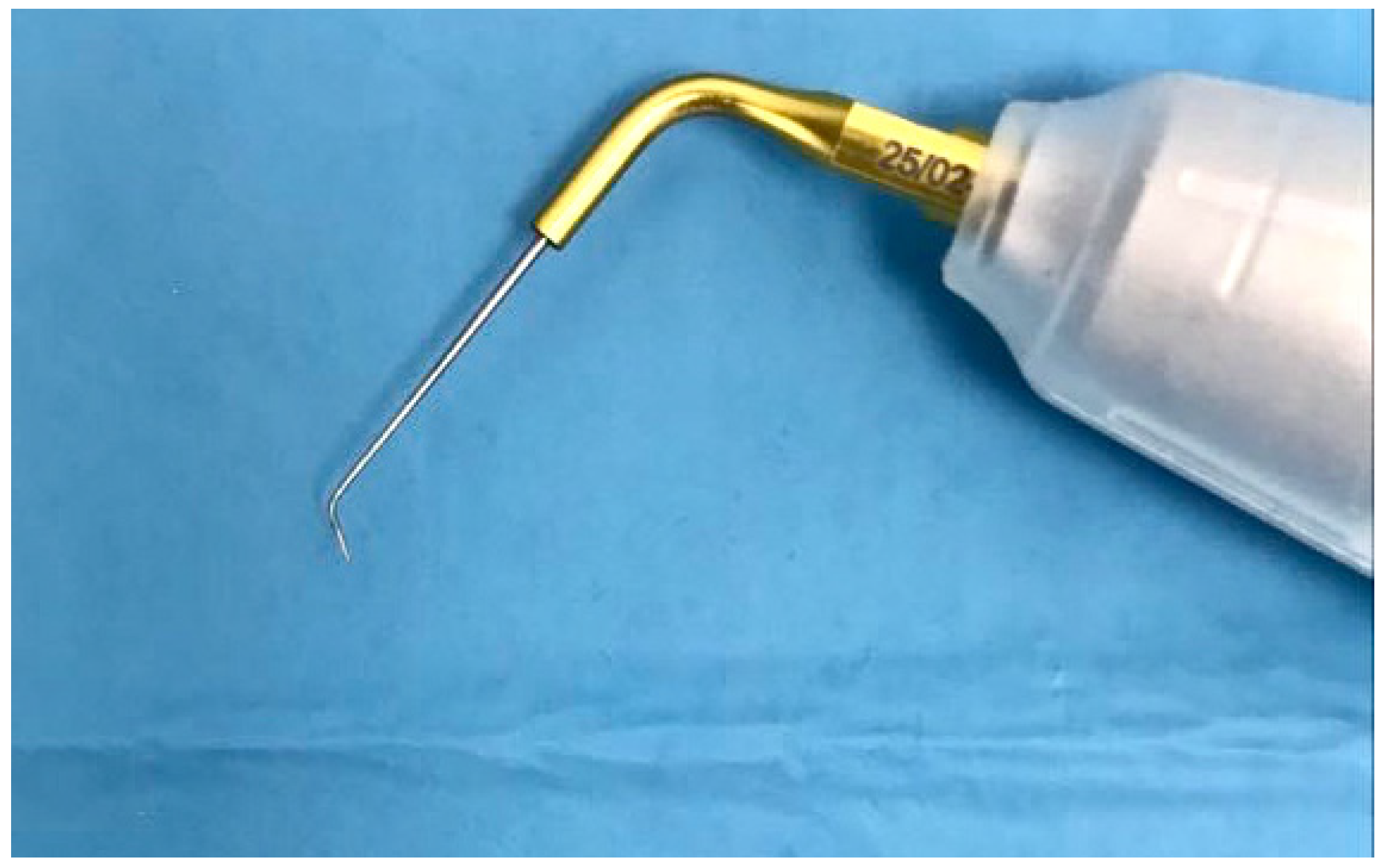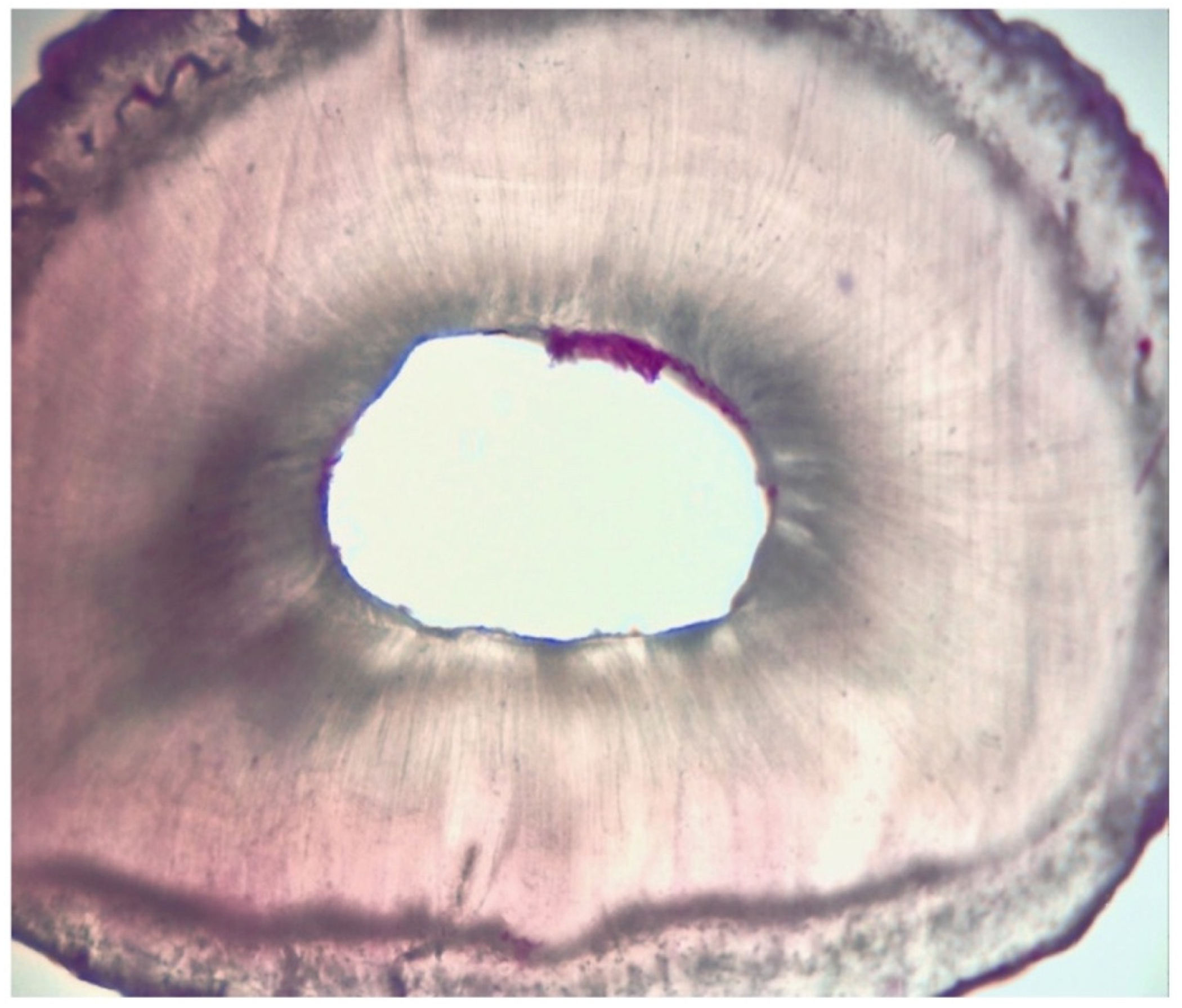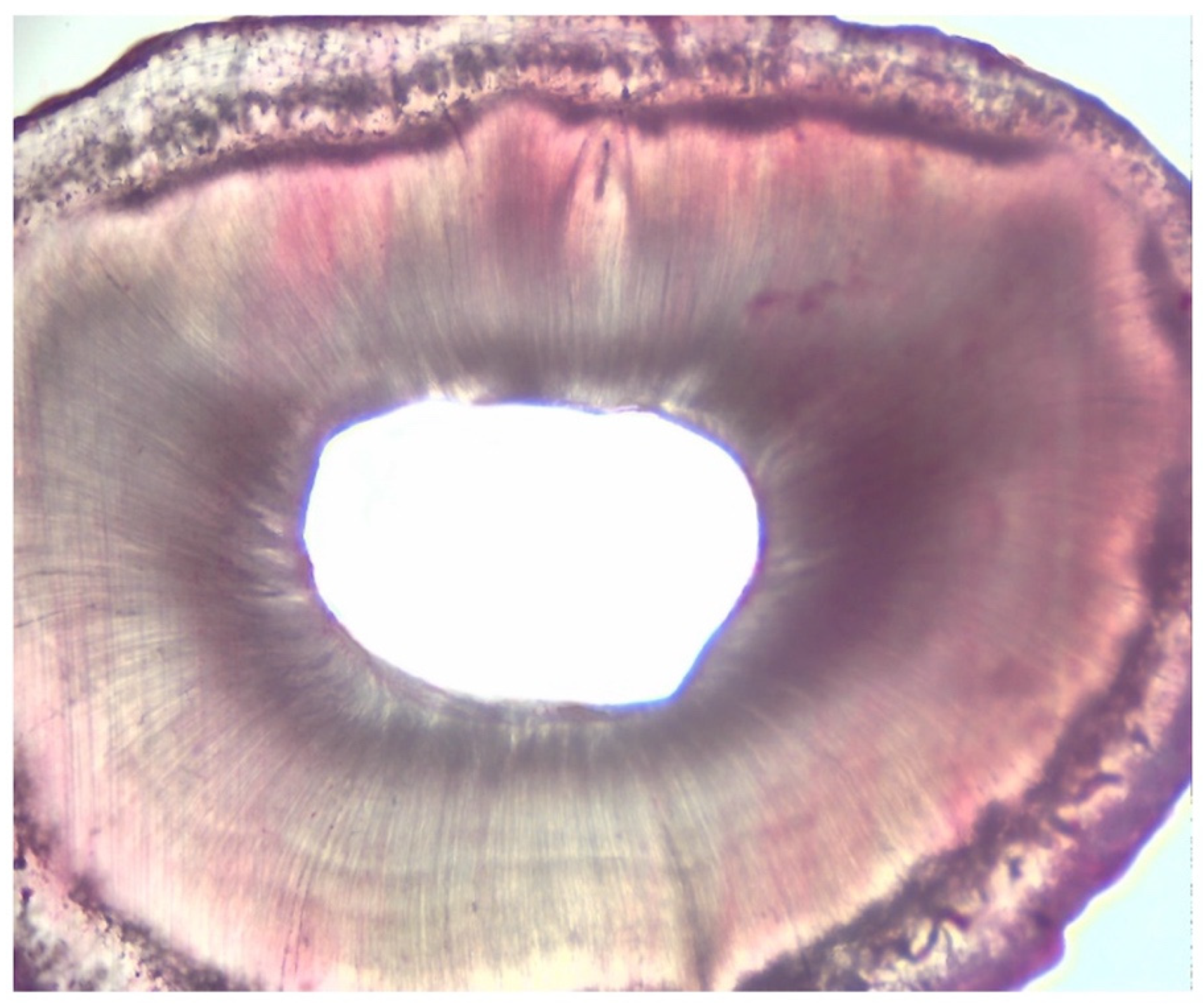Histological Evaluation of Root Canals by Performing a New Cleaning Protocol “RUA” in Endodontic Surgery
Abstract
1. Introduction
2. Materials and Methods
2.1. Specimen Selection
2.2. Root Canal Preparation
2.3. Assessment of Root Canal Cleanliness
2.4. Statistical Analysis
3. Results
4. Discussion
5. Conclusions
Author Contributions
Funding
Institutional Review Board Statement
Informed Consent Statement
Data Availability Statement
Conflicts of Interest
References
- Iandolo, A.; Amato, M.; Pantaleo, G.; Abdellatif, D.; Blasi, A.; Gagliani, M. An in vitro evaluation of the degree of pulp tissue dissolution through different root canal irrigation protocols. J. Conserv. Dent. 2018, 21, 175–179. [Google Scholar] [CrossRef] [PubMed]
- Teja, K.V.; Ramesh, S.; Battineni, G.; Vasundhara, K.A.; Jose, J.; Janani, K. The effect of various in-vitro and ex-vivo parameters on irrigant flow and apical pressure using manual syringe needle irrigation: Systematic review. Saudi Dent. J. 2022, 34, 87–99. [Google Scholar] [CrossRef] [PubMed]
- Iandolo, A.; Amato, M.; Dagna, A.; Poggio, C.; Abdellatif, D.; Franco, V.; Pantaleo, G. Intracanal heating of sodium hypochlorite: Scanning electron microscope evaluation of root canal walls. J. Conserv. Dent. 2018, 21, 569–573. [Google Scholar] [CrossRef]
- Teja, K.V.; Sindhu Ramesh, S. Is a filled lateral canal—A sign of superiority? J. Dent. Sci. 2020, 15, 562–563. [Google Scholar] [CrossRef] [PubMed]
- Ng, Y.-L.; Mann, V.; Gulabivala, K. Outcome of secondary root canal treatment: A systematic review of the literature. Int. Endod. J. 2008, 41, 1026–1046. [Google Scholar] [CrossRef] [PubMed]
- European Society of Endodontology. Quality guidelines for endodontic treatment: Consensus report of the European Society of Endodontology. Int. Endod. J. 2006, 39, 921–930. [Google Scholar] [CrossRef]
- Lofthag-Hansen, S.; Huumonen, S.; Grondahl, K.; Grondahl, H.G. Limited cone-beam CT and intraoral radiography for the diagnosis of periapical pathology. Oral Surg. Oral Med. Oral Pathol. Oral Radiol. Endodontol. 2007, 103, 114–119. [Google Scholar] [CrossRef]
- Carr, G.B. Microscopes in Endodontics. Calif. Dent. Assoc. J. 1992, 11, 55–61. [Google Scholar]
- Carr, G.B. Ultrasonic Root End Preparation. Dent. Clin. N. Am. 1997, 41, 541–554. [Google Scholar] [CrossRef]
- Von Arx, T.; Walker, W. Microsurgical instruments for root-end cavity preparation following apicoectomy: A literature review. Endod. Dent. Traumatol. 2000, 16, 47–62. [Google Scholar] [CrossRef]
- Iandolo, A.; Simeone, M.; Riccitiello, F. The preparation of coronal isthmus is a fundamental step for long term success. G. Ital. Endod. 2012, 26, 150–154. [Google Scholar] [CrossRef]
- Iandolo, A.; Amato, A.; Martina, S.; Abdellatif, D.A.; Pantaleo, G. Management of severe curvatures in root canal treatment with the new generation of rotating files using a safe and predictable protocol. Open Dent. J. 2020, 14, 421–425. [Google Scholar] [CrossRef]
- Iandolo, A.; Abdellatif, D.; Barbosa, A.F.A.; Scelza, G.; Gasparro, R.; Sammartino, P.; Silva, E.J. Confocal laser scanning microscopy evaluation of roots subjected to activation protocol in endodontic microsurgery. Aust. Endod. J. 2021, 48, 77–81. [Google Scholar] [CrossRef] [PubMed]
- Di Spirito, F.; Pisano, M.; Caggiano, M.; Bhasin, P.; Lo Giudice, R.; Abdellatif, D. Root Canal Cleaning after Different Irrigation Techniques: An Ex Vivo Analysis. Medicina 2022, 58, 193. [Google Scholar] [CrossRef] [PubMed]
- Hirsch, J.M.; Ahlström, U.; Henrikson, P.A.; Heyden, G.; Peterson, L.E. Periapical surgery. Int. J. Oral. Surg. 1979, 8, 173–185. [Google Scholar] [CrossRef] [PubMed]
- Iandolo, A.; Pisano, M.; Scelza, G.; Abdellatif, D.; Martina, S. Three-Dimensional Evaluation of the Root Apex of Permanent Maxillary Premolars: A Multicentric Study. Appl. Sci. 2022, 12, 6159. [Google Scholar] [CrossRef]
- Gray, G.J.; Hatton, J.F.; Holtzmann, D.J.; Jenkins, D.B.; Nielsen, C.J. Quality of root-end preparations using ultrasonic and rotary instrumentation in cadavers. J. Endod. 2000, 26, 281–283. [Google Scholar] [CrossRef] [PubMed]
- Gutmann, J.L. Surgical endodontics: Past, present, and future. Endod. Top. 2014, 30, 29–43. [Google Scholar] [CrossRef]
- Carratù, P.; Amato, M.; Riccitiello, F.; Rengo, S. Evaluation of leakage of bacteria and endotoxins in teeth treated endodontically by two different techniques. J. Endod. 2002, 28, 272–275. [Google Scholar] [CrossRef]
- Kim, S. Principles of endodontic microsurgery. Dent. Clin. N. Am. 1997, 41, 481–497. [Google Scholar] [CrossRef]
- Gilheany, P.A.; Figdor, D.; Tyas, M.J. Apical dentin permeability and microleakage associated with root end resection and retrograde filling. J. Endod. 1994, 20, 22–26. [Google Scholar] [CrossRef] [PubMed]
- Kim, S.; Kratchman, S. Modern endodontic surgery concepts and practice: A review. J. Endod. 2006, 32, 601–623. [Google Scholar] [CrossRef] [PubMed]
- Valencia, Y.M.; Vertuan, G.C.; Alcalde, M.P.; Vivan, R.R.; Reis Só, M.V.; Duarte, M.A.H. Effect of Irrigating Agitation after Root End Preparation on the Wall Cleaning and Bond Strength of Calcium Silicate Material in Retrograde Obturation. Eur. J. Dent. 2021, 15, 707–713. [Google Scholar] [CrossRef] [PubMed]
- Iandolo, A.; Abdellatif, D.; Pantaleo, G.; Sammartino, P.; Amato, A. Conservative shaping combined with three-dimensional cleaning can be a powerful tool: Case series. J. Conserv. Dent. 2020, 23, 648–652. [Google Scholar] [CrossRef] [PubMed]
- Iandolo, A.; Dagna, A.; Poggio, C.; Capar, I.; Amato, A.; Abdellatif, D. Evaluation of the actual chlorine concentration and the required time for pulp dissolution using different sodium hypochlorite irrigating solutions. J. Conserv. Dent. 2019, 22, 108–113. [Google Scholar] [CrossRef]



| Grading | |
|---|---|
| I | presence of debris within the area |
| II | presence of debris in more than 50% of the entire area |
| III | presence of debris in more than 25% of the entire area |
| IV | absence of debris or presence of debris in less than 25% of the entire area |
| Experiment A | |
|---|---|
| Group 1 | 2 [0.5] A |
| Group 2 | 4 [1] B |
| No. | A1 1 | A1 2 | A1 3 | A1 4 | A1 5 | A1 6 | A1 7 | A1 8 | A1 9 | A1 10 | A1 11 | A1 12 | A1 13 | A1 14 | A1 15 | A1 16 | A1 17 | A1 18 | A1 19 | A1 20 |
|---|---|---|---|---|---|---|---|---|---|---|---|---|---|---|---|---|---|---|---|---|
| Score | I | II | II | I | II | III | II | II | II | I | II | I | II | III | II | II | III | II | I | II |
| No. | A2 1 | A2 2 | A2 3 | A2 4 | A2 5 | A2 6 | A2 7 | A2 8 | A2 9 | A2 10 | A2 11 | A2 12 | A2 13 | A2 14 | A2 15 | A2 16 | A2 17 | A2 18 | A2 19 | A2 20 |
|---|---|---|---|---|---|---|---|---|---|---|---|---|---|---|---|---|---|---|---|---|
| Score | III | IV | IV | III | IV | III | III | IV | III | IV | IV | III | IV | IV | III | III | IV | IV | IV | IV |
Disclaimer/Publisher’s Note: The statements, opinions and data contained in all publications are solely those of the individual author(s) and contributor(s) and not of MDPI and/or the editor(s). MDPI and/or the editor(s) disclaim responsibility for any injury to people or property resulting from any ideas, methods, instructions or products referred to in the content. |
© 2023 by the authors. Licensee MDPI, Basel, Switzerland. This article is an open access article distributed under the terms and conditions of the Creative Commons Attribution (CC BY) license (https://creativecommons.org/licenses/by/4.0/).
Share and Cite
Iandolo, A.; Amato, A.; Pisano, M.; Sangiovanni, G.; Abdellatif, D.; Fornara, R.; Simeone, M. Histological Evaluation of Root Canals by Performing a New Cleaning Protocol “RUA” in Endodontic Surgery. Dent. J. 2023, 11, 78. https://doi.org/10.3390/dj11030078
Iandolo A, Amato A, Pisano M, Sangiovanni G, Abdellatif D, Fornara R, Simeone M. Histological Evaluation of Root Canals by Performing a New Cleaning Protocol “RUA” in Endodontic Surgery. Dentistry Journal. 2023; 11(3):78. https://doi.org/10.3390/dj11030078
Chicago/Turabian StyleIandolo, Alfredo, Alessandra Amato, Massimo Pisano, Giuseppe Sangiovanni, Dina Abdellatif, Roberto Fornara, and Michele Simeone. 2023. "Histological Evaluation of Root Canals by Performing a New Cleaning Protocol “RUA” in Endodontic Surgery" Dentistry Journal 11, no. 3: 78. https://doi.org/10.3390/dj11030078
APA StyleIandolo, A., Amato, A., Pisano, M., Sangiovanni, G., Abdellatif, D., Fornara, R., & Simeone, M. (2023). Histological Evaluation of Root Canals by Performing a New Cleaning Protocol “RUA” in Endodontic Surgery. Dentistry Journal, 11(3), 78. https://doi.org/10.3390/dj11030078










